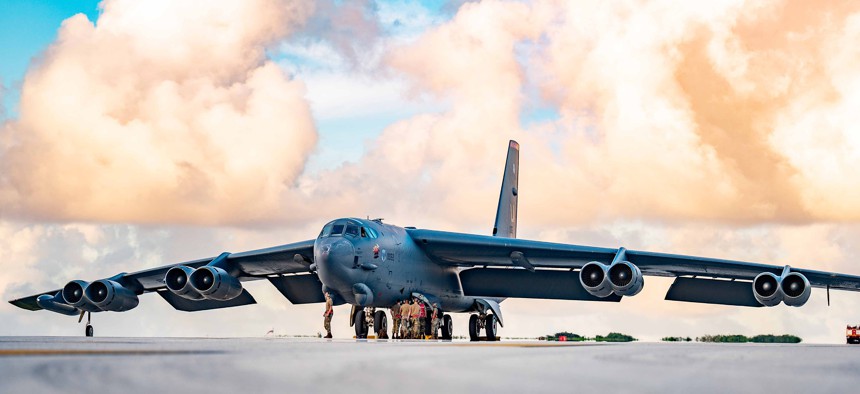
A B-52 Stratofortress at Andersen Air Force Base, Guam, April 11, 2023. U.S. Air Force / Airman 1st Class William Pugh
Boeing is using Fortnite’s game engine to upgrade B-52s
Will this “hyper-realistic” modeling tool help get the program a Victory Royale?
A popular gaming engine is helping Boeing to refit 60-year-old B-52 bombers for another three decades of service.
To see how new Rolls-Royce F-130 engines would work on the U.S. Air Force’s Stratofortresses, the plane-maker turned to Unreal Engine 5, the software that powers the Fortnite shoot-’em-up game. The game engine’s 3D environment lets pilots and maintainers virtually interact with a digital representation of the upgraded B-52, like starting up and shutting down an engine.
It’s a “really impressive, powerful tool,” said Jennifer Wong, Boeing’s senior director for bombers.
Wong said commercial digital software, like the “hyper-realism capabilities” in Unreal Engine 5, reduces cost and delivery time.
“We learn faster and we're able to adjust quicker when we're talking about models than [when] we are learning after we bend metal,” she told reporters last week at the Air & Space Forces Association’s annual Air, Space & Cyber conference.
The virtual environment gives the Air Force “unprecedented access” to the modifications early on and gives Boeing feedback well before they begin upgrading aircraft, Wong said.
This is part of a modernization effort called the Commercial Engine Replacement Program, or CERP, which will replace the eight Pratt & Whitney TF33 engines on each jet to keep the bomber flying.
The program is much bigger than just engine replacement, Wong said, as Boeing will also update the displays, cockpits, and other avionics systems in the plane.
Rolls-Royce is on track to complete initial engine testing by the end of the year and begin “critical design review” in the first quarter of 2024.
Boeing will also replace the B-52’s current radars with Raytheon’s active electronically scanned array radar, called AESA. The radar is already used in the U.S. Navy’s F/A-18E and F Super Hornets.
“When we say things like ‘the B-52 will have fighter-like capabilities in the future,’ that is what we mean. Eventually, the B-52 will be able to have some sense of a fighter-like capability and some of that visualization that is currently in the F-18 platform,” Wong said.
The new radar will enable the B-52 to track multiple targets simultaneously, Wong said. Other upgrades in the radar program include a new wide-band radome, which protects the radar antenna, large touchscreen digital displays for the navigators, and hand controllers.
“This will allow us to be able to continue to advance the capabilities in the future because advancement will be done via software as opposed to hardware changes going forward,” Wong said.
Raytheon recently announced that it had delivered the first AESA radar to Boeing for the program.
These modernization programs are crucial, as the B-52 could flying even beyond the 2050s, according to Col. Scott Foreman, Air Force B-52 program leader. Foreman pointed to the almost half-century-old A-10 Warthog as an example of a plane that’s still flying after multiple attempts from the Air Force to retire it.
“Even though we're saying 2050, I have no reason to believe that it couldn't be flying for long after that,” Foreman said at the AFA conference.
Boeing said they will have all B-52s modified with the new radar by the end of fiscal 2031 and the engine replacement program completed by the end of fiscal 2036.




